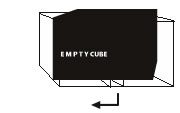LARA MORAIS
SEPTEMBER, 25, 2008

CONTACT
laraboticario@gmail.com
EXHIBITION INFORMATION
Diagrams
Graphite and charcoal drawing on the walls and the floor.
Enter.
Lara Morais systematically carries out a questioning of everyday actions. Her work stands on the threshold of a critical, political stance. Her pieces offer, by means of an elaborate reflective structure, a second look at our shared tensions in the society in which we live, where identity and otherness confront themselves with the diversity of devices that develop our modus vivendi in a common context.
Space is a determinant category in the conceptual construction of her works, often becoming their central element. It is like a platform that allows her to articulate a network of connections denotative of her critical stance.
The project shown at emptycube consists of two moments: a diagram and a geometric surface. The existence of these two moments does not imply a precedence, or succession, of one regarding the other; instead, they are two forms of a dialectic process through which the artist examines the validity of human relations as a condition of individual identity within the field of spatial co-ordinates. Its title, Diagramas [Diagrams], indicates at once a rational, practical need to establish an orientation system within an apparently dispersed universe of references. In this particular project, the use of language is of the greatest relevance, first and foremost because it shows how close the connection between the artist’s procedural universe and the conceptual heritage is, inviting the viewer to linger in the presence of the text, words and lines that make up this diagram, which is like a plan or map displaying a system of relations between words which contain a meaning derived from various subcategories, selected by the artist from a common, though abstract, concept: space. Yet, for Lara Morais, the Diagram is just an approximation. There is a certain amount of irony in this discursive action on space, given that its place of exhibition is called emptycube, something we may associate to an inner space devoid of distinctive features, to the inexistence, in that space, of a body that may define it, distinguishing it from other empty spaces. There is also an absolute starkness and lack of concern regarding the obligatory presence of the three-dimensional object, which effectively determines the division of that space.
The main room, in which the geometrical object is to be found, is the fulfilment of the proposition contained in the diagram. A metre-high cube alludes to the objective possibility of defining a space inside the room. This is a deceptive (and reflective) experience, since its existence can only be recognised if one understands that the projections of the cube’s sides are inscribed on the room’s walls. If the cube’s function is to determine a position, that place we are supposed to look for is found by each one of the visitors through the corporeality of their presence, at the moment in which they are there. Thus the relation between space and time is indicated in the transitory, unrepeatable instant of the viewer’s presence. This, besides being a metaphor for one’s possession of that place on that moment, is also its only possibility. Diagramas is an endeavour that unfolds itself across the orientation plan built and drawn by the artist and the geometric form each of the visitors will have to reconstruct, in order to confirm their position in a given point in space and find their place there. The room is public, but the moment is individual and private.
Lara Morais points out how vital it is for us to recognise the identity made actual through one’s singularity in a given place. That determination in space relies on the relative distance from one body to another, and its possession lies in the transitoriness of its presence.
João Silvério
September 2008




